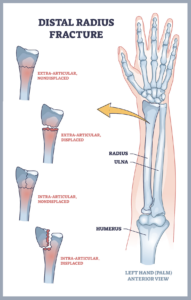 The wrist is a complex joint made up of several parts arranged to help our hand move and control the environment around us. Unfortunately, all these moving parts also make the wrist prone to injury. In fact, a wrist fracture (break) and a wrist sprain are some of the most common orthopaedic injuries. They are also some of the most common sports-related injuries.
The wrist is a complex joint made up of several parts arranged to help our hand move and control the environment around us. Unfortunately, all these moving parts also make the wrist prone to injury. In fact, a wrist fracture (break) and a wrist sprain are some of the most common orthopaedic injuries. They are also some of the most common sports-related injuries.
Wrist sprains and fractures are alike in many ways. Both often result from a fall on an outstretched hand (“FOOSH”) or another traumatic event, like a car wreck. Furthermore, they each can cause pain, tenderness, swelling and bruising. In fact, the two are so similar that people often mistake them for one another, as can happen with sprains and fractures of the ankle. So, how can you tell a wrist sprain from a wrist fracture? We’ll discuss this and more in the following post.
First, we’ll explain what wrist sprains and wrist fractures are. Then, we’ll explore the differences between the two, including how they are treated. Finally, we’ll let you know when it’s time to see a doctor.
What is a wrist sprain?
A wrist sprain refers to damage to a ligament. Ligaments are the fibrous bands of tissue that connect bones to each other. Essentially, sprains occur when one or more ligaments are torn or stretched beyond their limits. Often sprains are rated as a grade 1, 2, or 3 depending on how many ligaments are involved and whether those ligaments are stretched, partially torn, or completely torn. Often, wrist sprains are caused by an injury to the scapholunate ligament, an important ligament that connects the scaphoid bones to the lunate carpal bones.
 What is a wrist fracture?
What is a wrist fracture?
A wrist fracture refers to a break in a bone. The fracture can be a non-displaced crack in the bone, meaning the bone is not out of place. But they can also be displaced resulting in a disruption in the normal alignment of the bone. The most common type of wrist fracture is a distal radius fracture, which occurs at the end of the long radius bone of the forearm. Another type of fracture called a “scaphoid fracture”, involves one of the eight small round carpal bones in the wrist.
How can you tell the difference between the two?
Now you know that a wrist sprain refers to damage to one or more ligaments (fibrous tissues between bones) and a wrist fracture is an actual break in the bone. Yet, you may still find it difficult to determine which injury you’ve experienced. So, if you’re still asking, “Is my wrist sprained or broken?” try answering the following questions:
-
Are there any obvious deformities of the wrist, such as an unnatural bend, or bone matter breaking through the skin?
Typically, these are signs of a more severe broken bone and require immediate medical attention. However, be aware that wrist fractures are not always overtly visible to the naked eye.
-
Did you hear anything at the time of the injury?
Most often, a sprain either occurs silently or maybe with a “popping” sound in severe instances. However, when a fracture occurs, you may hear a “crack”. You may also experience a slight “grinding” or “crunching” sound upon movement after the injury occurs.
-
Can you move your wrist?
A fracture can cause the bones of the wrist to shift out of line, considerably limiting the wrist’s range of motion and making it difficult to move. Though painful, a sprain may still allow you to move your wrist.
-
Are you experiencing numbness or tingling in your hand and/or fingers?
With a fracture comes a greater chance of nerve and/or blood vessel damage, possibly causing numbness or tingling in the hands and fingers. If this occurs, you should seek medical attention immediately, as a loss of blood flow can have significant, long-term effects and may require surgery.
-
What type of pain are you experiencing?
While immobilized, fracture pain is often described as “achy”, while sprains may cause more of a “throbbing” pain. However, one is not necessarily more painful than the other when it comes to sprains and fractures. It depends on the extent of the injury. In fact, wrist sprains and fractures can both be associated with a wide variety of pain levels.
Importantly, wrist sprains and fractures are not mutually exclusive. So, it’s possible to experience both at the same time. In fact, sprain/fracture combinations are quite common. So, be sure to seek medical advice to ensure you receive a correct and complete diagnosis.
 How is a wrist sprain treated?
How is a wrist sprain treated?
Thankfully, wrist sprains don’t usually require surgery. However, we recommend seeking medical attention regardless, as even a severe grade 3 sprain may present with only minor symptoms.
Often, milder wrist sprains respond well to conservative at-home treatments such as rest, ice, and over-the-counter anti-inflammatory medication, like ibuprofen. Though moderate sprains require longer healing time. You made need to be immobilized in a splint for a week or more. If you continue to experience discomfort and/or stiffness, you may also benefit from physical therapy.
With severe sprains in which one or more ligaments are completely torn, you may require surgery. This procedure involves reconnecting the ligament(s) to the bone to restore proper function and joint stability. Following surgery, you will likely need physical therapy to rehabilitate the wrist and return strength and flexibility to it.
How is a wrist fracture treated?
Some fractures can be treated without surgery if the bone fragments haven’t moved out of alignment very much and remain close together. In these cases, we often recommend immobilizing the wrist and hand with a splint or cast. During this time, we will monitor healing and adjust care as needed.
However, if the break is more severe and the bones have moved very far out of place and/or alignment, we may recommend surgery. This procedure usually includes inserting a small plate with screws to hold the bones in place and repair the wrist. Following surgery, you will likely need physical therapy to rehabilitate the wrist and return strength and flexibility to it.
When should I consult a doctor?
Generally, due to the complexity and delicacy of the wrist, we recommend seeking medical attention immediately for any symptoms that may be considered moderate to severe. This could include:
- Intense or severe pain
- Numbness and/or tingling
- Think the wrist could be fractured
- Your wrist looks deformed or unnatural
- Experience symptoms lasting more than two days
Advanced Ortho & Spine can help.
Advanced Ortho and Spine (AOS), we’ve cared for many patients with wrist sprains and fractures. Most are able to get back to living their best lives with only conservative treatment. Dr. Christopher Cook and Dr. Erik Maryniw specialize in treating a variety of orthopaedic conditions, including wrist sprains and fractures. Request an appointment online or call us at 615.885.0200 to schedule today.
 Dr. Christopher Cook is a Board-Certified Orthopaedic Surgeon and Sports Medicine & Joint Replacement Specialist at Advanced Ortho and Spine. He provides a full spectrum of Joint Replacement, Sports Medicine, and Shoulder & Upper Extremity services. Contact us today for more information or to request an appointment. Contact us today for more information or to request an appointment.
Dr. Christopher Cook is a Board-Certified Orthopaedic Surgeon and Sports Medicine & Joint Replacement Specialist at Advanced Ortho and Spine. He provides a full spectrum of Joint Replacement, Sports Medicine, and Shoulder & Upper Extremity services. Contact us today for more information or to request an appointment. Contact us today for more information or to request an appointment.

Dr. Erik Maryniw is a Board-Certified Hand and Upper Extremity Orthopaedic Surgeon at Advanced Ortho and Spine. He provides a full spectrum of orthopaedic care and microvascular surgery from the hand to the shoulder. Contact us today for more information or to request an appointment.

With two locations near Nashville in Mt. Juliet and Hermitage, Advanced Ortho and Spine provides patients with high-quality, personalized care. We also strive to advance orthopaedic excellence. Contact us today to learn more or to schedule your appointment.
Disclaimer: This blog provides general information and discussions about health and related subjects. The information and other content provided in this blog, or in any linked materials, are not intended and should not be construed as medical advice, nor is the information a substitute for professional medical expertise or treatment.If you or any other person has a medical concern, you should consult with your healthcare provider or seek other professional medical treatment. Never disregard professional medical advice or delay in seeking it because of something read on this blog or in any linked materials. If you think you may have a medical emergency, call your doctor or emergency services immediately.
The opinions and views expressed on this blog and website have no relation to those of any academic, hospital, health practice, or other institution.

